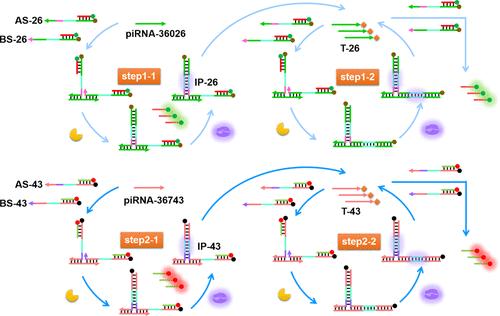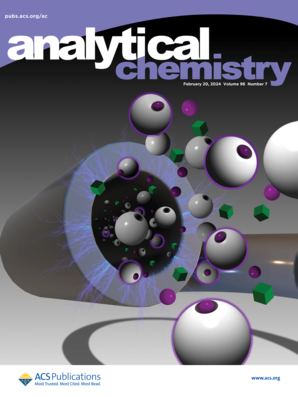Development of a Single-Molecule Biosensor Based on Polymerization-Transcription-Mediated Target Regeneration for Simultaneously One-Pot Detection of Multiple piRNAs
IF 6.7
1区 化学
Q1 CHEMISTRY, ANALYTICAL
引用次数: 0
Abstract
PIWI-interacting RNAs (piRNAs) are a class of small noncoding RNAs associated with PIWI proteins within the male germline, and they play significant roles in maintaining genome stability via the modulation of gene expression. The piRNAs are implicated in the progression of various cancers, but the simultaneous monitoring of multiple piRNAs remains a challenge. Herein, we construct a single-molecule biosensor based on polymerization-transcription-mediated target regeneration for the simultaneous one-pot detection of multiple piRNAs. This assay involves two cycles. In step 1, target piRNAs hybridize with the template probe complexes to yield three-way junction (3WJ) structures. Then, KF DNA polymerase initiates the extension to generate a complete T7 promoter, and the extension product can act as an invading strand to displace signal probes, resulting in the release of fluorophores. Then, in step 2, the T7 promoter can be recognized by T7 RNA polymerase to initiate transcription, producing abundant transcripts with 3′–OH that are identical to piRNAs. The resultant transcripts can hybridize with free template probe complexes to obtain new 3WJ structures that can be elongated by KF polymerase for the recovery of fluorescence signals. This assay can be performed homogeneously in a one-pot format within 30 min, and it exhibits high sensitivity, with a limit of detection (LOD) of 19.26 aM for piRNA-36026 and 41.88 aM for piRNA-36743. Moreover, it can simultaneously detect endogenous piRNAs at the single-cell level and differentiate piRNA expression in the tissues of healthy individuals and breast cancer patients, offering a prospective platform for clinic diagnosis.

求助全文
约1分钟内获得全文
求助全文
来源期刊

Analytical Chemistry
化学-分析化学
CiteScore
12.10
自引率
12.20%
发文量
1949
审稿时长
1.4 months
期刊介绍:
Analytical Chemistry, a peer-reviewed research journal, focuses on disseminating new and original knowledge across all branches of analytical chemistry. Fundamental articles may explore general principles of chemical measurement science and need not directly address existing or potential analytical methodology. They can be entirely theoretical or report experimental results. Contributions may cover various phases of analytical operations, including sampling, bioanalysis, electrochemistry, mass spectrometry, microscale and nanoscale systems, environmental analysis, separations, spectroscopy, chemical reactions and selectivity, instrumentation, imaging, surface analysis, and data processing. Papers discussing known analytical methods should present a significant, original application of the method, a notable improvement, or results on an important analyte.
 求助内容:
求助内容: 应助结果提醒方式:
应助结果提醒方式:


